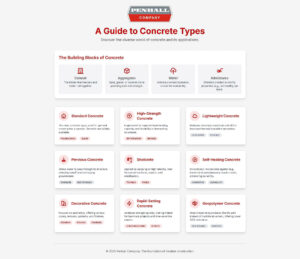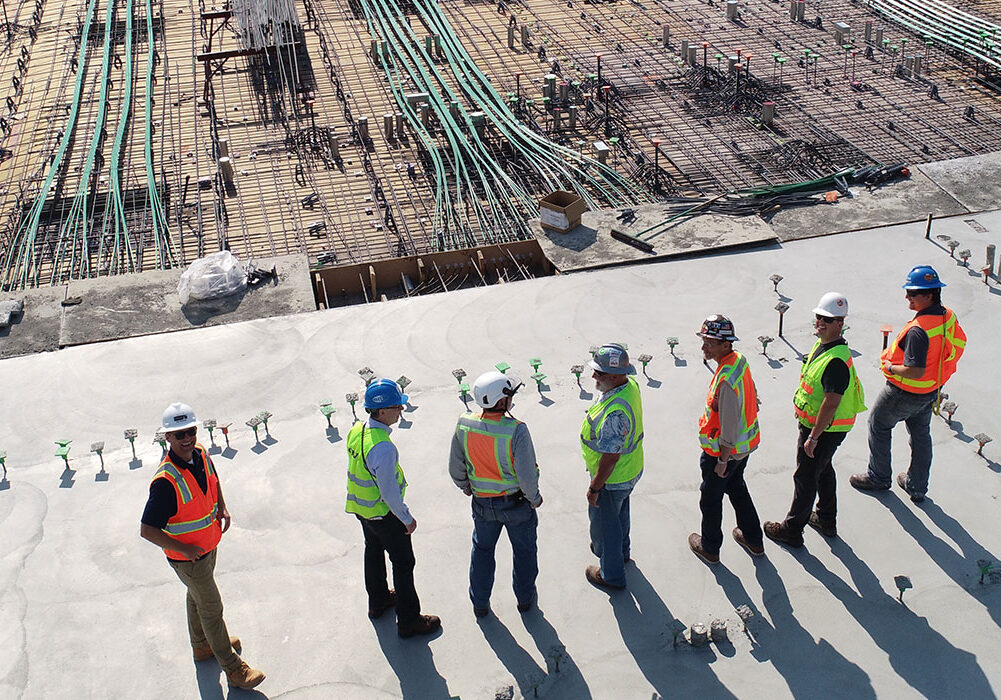Concrete is one of the most commonly used construction materials in the world. Wherever there is any inkling of infrastructure, one can almost always find concrete there as well. Not all concrete is the same, however. Understanding these different types is crucial for selecting the right material for specific construction projects, ensuring optimal durability, strength, and cost-effectiveness. There are various types of concrete that exist in the world for numerous uses. One of the oldest concrete recipes from the Romans was a mix of volcanic ash and hydrated lime. But it has been a few centuries since then; in that time, concrete has developed and has become both advanced and increasingly diverse.
Modern Concrete
Most commonly, regular concrete is created by mixing Portland cement with both an aggregate and water-chemical mixtures. Portland cement serves as the primary binding agent, while aggregates (which can include sand, gravel, or crushed stone) provide volume and structural stability. The water-cement ratio is crucial, as it directly impacts the concrete’s strength and workability. Often times, cement and concrete are incorrectly interchanged: concrete is the hard, rock-like substance that is so frequently seen in urbanized areas. Cement is an ingredient, the powder, used in the creation of concrete. It is the most-produced material on Earth and will continue to be so long as there is a need to create, rebuild, or improve infrastructure.
Key Properties of Standard Concrete:
- Compressive Strength: Typically 2,500-5,000 psi (17-34 MPa)
- Tensile Strength: Relatively low, about 10% of compressive strength
- Common Applications: Foundations, sidewalks, floors, basic structural elements
- Advantages: Cost-effective, versatile, readily available
- Limitations: Requires reinforcement for tensile loads, susceptible to cracking
High-Strength Concrete
High-strength concrete is different from normal-strength concrete in the amount of force it can resist without breaking. The American Concrete Institute differentiates high-strength from normal-strength at a compressive strength of over 6,000 psi (pounds square inch). In addition to varying the proportions of the materials used in normal-strength concrete, silica fume (a byproduct of silicon metal production that acts as a pozzolanic admixture) is added to the mixture in order to strengthen the bond between the cement and the aggregate. However, this admixture causes the cement to hydrate much faster, meaning that it dries quicker than usual. In order to keep consistent the balance between workability and strength, a superplasticizer (a type of high-range water-reducing admixture) is added to high-strength concrete. This slows down the chemical reaction between the cement and water, allowing for workers to place the concrete at a more effective pace.
Key Properties and Applications:
- Compressive Strength: 6,000-15,000 psi (41-103 MPa)
- Common Applications: High-rise buildings, bridges, heavy-load bearing structures
- Advantages: Allows for smaller structural elements, greater durability, reduced maintenance
- Limitations: Higher cost, requires precise mix design and quality control
High-Performance Concrete (HPC)
High-performance concrete, in contrast to high-strength concrete, is not necessarily known for its compressive resistance. While high-performance concrete can include a high compressive strength, other characteristics used to define “high performance” are the ease of placement without affecting strength, long-term mechanical properties, toughness, and longevity in various weather conditions among others.
HPC is engineered to deliver specific performance characteristics beyond standard strength requirements. These may include:
- Enhanced Durability: Resistance to freeze-thaw cycles, chemical attack, and abrasion
- Low Permeability: Reduced water and chloride ion penetration
- Controlled Shrinkage: Minimized cracking during curing
- Common Applications: Marine structures, bridges, parking structures, and environments with harsh exposure conditions
- Composition: Often includes supplementary cementitious materials like fly ash, slag cement, or silica fume
Ultra High-Performance Concrete
This type of concrete is more often than not pre-mixed in bags because of the numerous ingredients needed to make it. It includes Portland cement, silica fume, quartz flour, and fine silica sand. However, high-range water reducers, water, and other steel or organic fibers are used to increase the strength of the mixture. Ultra-high performance concrete is particularly durable because of the combination of fine powders. Other types of concrete normally need a steel rebar or reinforcing to retain the intended structure, but UHPC is generally self-placing in addition to its incredible compressive strength of up to 29,000 psi. Its post-cracking longevity is one of UHPC’s strong points because even after this concrete cracks, it still is able to maintain structural integrity with an impressive tensile strength of 725 psi.
Key Properties of UHPC
- Compressive Strength: 17,000-29,000 psi (120-200 MPa)
- Tensile Strength: Approximately 725 psi (5 MPa)
- Durability: Exceptional resistance to environmental degradation
- Common Applications: Bridge connections, architectural elements, thin structural members, blast-resistant structures
- Advantages: Reduced section sizes, exceptional durability, minimal maintenance requirements
- Limitations: Significantly higher cost, specialized mixing and placement procedures
Stamped Concrete
Stamped concrete is another type of concrete that is very commonly used. Often seen in parking lots, pavements, or other like high-traffic areas, stamped concrete has more of an architectural application. Once concrete has been laid, a kind of mold can be placed on top of, or stamped, onto the hardening concrete to create the appearance of natural stone. Once the floor has been hardened, it will likely be sealed to increase the longevity of the dried mixture.
This decorative concrete option offers numerous benefits:
- Aesthetic Versatility: Can mimic the appearance of brick, slate, flagstone, tile, wood, and other materials
- Customization: Available in various colors, patterns, and textures
- Common Applications: Patios, driveways, pool decks, walkways, interior flooring
- Advantages: More economical than natural stone, durable, low maintenance
- Considerations: Requires skilled installation, may need periodic resealing
Self-Consolidating Concrete
Normally, concrete requires a mechanical vibration while being set in order to release excess air that may be in the mixture. Self-consolidating concrete eliminates the need for mechanical consolidation (the vibrations) mainly through its malleable viscosity. Being able to control the flowability and stability, as achieved by using high-range-water-reducing admixtures, allows concrete to be placed quicker. Not only does this save time, but because there is no need for the mechanical consolidation, self-consolidating concrete saves labor, saves money, and makes it easier for workers to fill restricted or hard-to-reach areas.
Key Characteristics:
- Flowability: Exceptional ability to flow and fill formwork without segregation
- Composition: Contains specialized viscosity-modifying admixtures and superplasticizers
- Common Applications: Complex formwork, congested reinforcement areas, architectural concrete
- Advantages: Reduced labor costs, improved surface finish, reduced noise during placement
- Considerations: Higher material cost, requires precise mix design
Shotcrete
Invented by taxidermist Carl Akeley in 1907, the initial dry method for placing shotcrete was by using a compressed air nozzle to shoot dry mix and injecting water through a separate hose at the head of the nozzle while the dry material is hurled toward the wall. The wet-mix shotcrete was developed later in the 1950’s and is only slightly different than the dry-mix shotcrete wherein dry-mix shotcrete involves the continuous feeding of a hopper through which dry mix would shoot through a nozzle and mix at the point of exit. Wet-mix shotcrete, however, involves the use of pre-mixed concrete. The concrete has already been prepared and therefore only involves one pump. The upside to using wet-mix shotcrete is that dry-mix shotcrete creates more waste (excess powder that falls to the floor), more rebound off the wall, and wet-mix shotcrete can place a larger quantity in a smaller amount of time.
Applications and Properties:
- Common Uses: Swimming pools, tunnel linings, slope stabilization, structural repairs, earth retention systems
- Advantages: Can be applied to vertical or overhead surfaces, minimal formwork required
- Compressive Strength: Typically 4,000-7,000 psi (28-48 MPa), but can be engineered for higher strengths
- Considerations: Requires skilled operators, proper technique to minimize rebound and ensure compaction
Limecrete
Also known as lime concrete, limecrete is a type of concrete where instead of using cement in the mix, lime is replaced. Doing so has certain benefits environmentally and health-wise. Environmentally, lime absorbs carbon dioxide as it sets and allows natural products like wood, straw, and hemp to be used as fibers without fear of composting or deterioration since limecrete controls moisture. In terms of health, lime plaster draws moisture out from inside which means that humidity control is more regulated, resulting in mold growth prevention. Furthermore, limewash and lime plasters are non-toxic so they do not contribute to air pollution inside like other paints would.
Key Properties and Benefits:
- Environmental Impact: Lower carbon footprint than Portland cement concrete, carbon sequestration during curing
- Breathability: Allows moisture movement, reducing dampness in buildings
- Compatibility: Ideal for historic building restoration and natural building methods
- Common Applications: Historic renovations, eco-friendly construction, breathable floor systems
- Limitations: Lower strength than conventional concrete, longer curing time
Reinforced Concrete
Reinforced concrete combines standard concrete with steel reinforcement (typically in the form of rebar or mesh) to overcome concrete’s inherent weakness in tension. This combination creates a composite material that can withstand both compressive and tensile forces effectively. The steel reinforcement is strategically placed to resist tensile stresses, while the concrete primarily handles compression.
Key Characteristics:
- Composition: Concrete with embedded steel reinforcement (rebar, mesh, or fibers)
- Strength Properties: High compressive strength from concrete, tensile strength from steel
- Common Applications: Beams, columns, slabs, foundations, bridges, and most structural concrete elements
- Advantages: Versatility, durability, fire resistance, relatively economical
- Considerations: Potential for corrosion of reinforcement if water penetrates to the steel
Pervious Concrete
Pervious (or permeable) concrete is designed specifically to allow water to pass through it, addressing stormwater management concerns and supporting sustainable construction practices. Unlike conventional concrete, it contains little or no sand, creating a network of interconnected voids that allow water to percolate through.
Key Properties:
- Porosity: Typically 15-25% void content
- Permeability: Can drain 3-8 gallons of water per minute per square foot
- Compressive Strength: Usually 2,500-3,500 psi (17-24 MPa)
- Environmental Benefits: Reduces stormwater runoff, recharges groundwater, reduces heat island effect
- Common Applications: Parking lots, low-traffic pavements, sidewalks, driveways
- Limitations: Lower strength than conventional concrete, requires regular maintenance to prevent clogging


